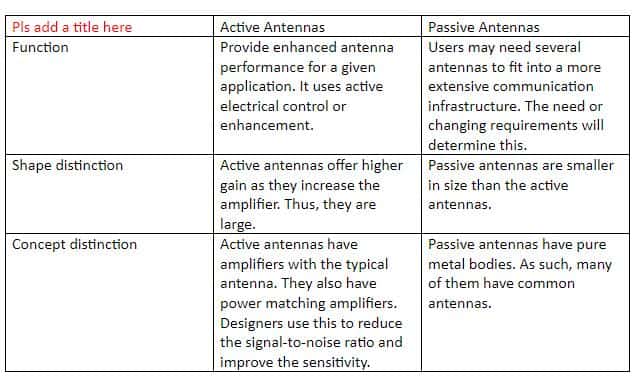https://www.youtube.com/watch?v=Du0G9MiH0sU
Active antennas can do many things on designers’ systems when used right. Thus, users need to understand the antenna tuning concept, which affects spectrum usage, dropped calls, or download speeds. Not only that, but operators must also understand the role of active and passive antenna systems.
Active antenna systems are not like passive antennas, and they automatically compensate for changes by adjusting themselves. These changes can be the detuning effects and frequency of the user’s hand and head. So, tablets and smartphones with active antennas can offer constant fast downlinks, and people can also get uplink connections with significantly little dropped calls.
Get Your Free Sample!
Explore our custom services now. Email us at [email protected] for more details.
What Are Active Antennas?

Active antennas contain active electronic components such as radio designs with antenna integration. So, people place importance on active antennas with the mobile system’s evolution. They have used the active antennas concept with conventional antennas for some time, and users have also recently applied this concept to textile wearable antennas.
There is no need for an active antenna system to have passive elements. Functional antenna units can transform traditional antennas with intelligent integration. It can contribute to base station efficiency, and operators can then increase the required coverage and capacity target for their system.
The active antenna system is a more advanced version of an active antenna. Thus, it may use a complete receive/send component. With amplitude and phase adjustment, this will enable beamforming. Multi-input multi-output capacity is another form of AAS, and Digital processing will also allow several spatial streams from a multi-element antenna array.
Active Antennas vs. Passive Antennas

Get Your Free Sample!
Explore our custom services now. Email us at [email protected] for more details.
Active Antenna Design
Active antennas provide a circularly polarized wave. With that, you will find active antennas the easiest to design. You only need to find a tube with one wavelength circumference. After that, wrap the wire in a helix with a space of about a quarter wavelength. Designers also don’t have to worry too much about the conductor width for the design. Thus, you will have greater directivity gain with a more significant number of turns. Active antennas have polarized waves. As such, winding transmitting and receiving antennas in the same direction is essential.
HF Active Antenna
HF active antennas cover a range of 100kHz or 80MHz, and their design makes them easy to install. People with antenna limited spaces or restrictions will find this helpful. Thus, you need to set up a full-size antenna. You can use it in various beamforming or noise cancellation. The design allows a broadband 50ohm productivity impedance. Besides, it also incorporates lightning and static protection. This process is proper for compelling most receivers.
With a corresponding push-pull output shield, you can use a J310 FET. Plus, this active device generates high yield second and third regulation figures, thus reducing potential received signals’ intermodulation. You can also incorporate power source decoupling with the design, and this process can feed the active circuit’s power through a coaxial cable.
Experts recommend about 1.9 meters of telescopic stainless steel for these antennas. When it comes to the low-frequency HF bands, the antenna is short physically. As for grounding on the active input circuit, it will look like a tiny 22pF capacitor. There may be potential for strong signals with antennas 2.5 meters long, and such a case may overwhelm an active circuit and lead to intermodulation.
Active Antennas: Pros and Cons
The active antenna has a primary advantage over regular networks, and it doesn’t need more spectrum. Nonetheless, it uses its unique potential to multiply the wireless connection capacity. So, you can see around a 50-fold increase from these considerable capacity improvements. Devices transmitting in higher frequency bands will also be more responsive, and this happens with enhanced coverage to get an excellent signal indoors.
When receiver and antenna RF cable length exceeds 10cm, the active antenna is helpful. You must only ensure that LNA doesn’t overload the receiver.
Pros
- Users can have a filter as part of the components. As such, there’s less impact for the active antenna to jam into the cable than the passive antenna.
- It works in keeping the receiver noise figure low.
- Active antennas can tolerate slight cable length or impedance incompatibility. Whereas the passive antenna cannot.
Cons
Active antennas need about 10 to 60 mW of power compared to the passive antenna.
Installation Warning and Location Considerations

It is strictly dangerous to install any antenna close to power lines. You must not install the antenna near other power circuits or electric lights. Essentially, you must be careful not to contact any courses. Otherwise, it can lead to death or severe injury.
The recommendation is to install an antenna away from the tower. Others are houses, power lines, or any structure with excellent noise sources. This course of action works well for location considerations. Passive wiring metal fencing or building can be a pickup antenna and re-radiate noise.
You can end received noise with the DXE-NCC-1 Receive Antenna Variable Phasing Controller, and they can combine that with two ARAH antennas. This case is perfect if the noise source is single and external directional in nature.
It is also essential to consider the lowest frequency. It is ideal to have a receive antenna about ½-wavelength away from any transmit antenna. Doing this can prevent the transfer of any noise the transmit antenna radiates, and it will also cut any mutual coupling. Users also need to power off the unit at least 5ms before sending it on the transmit antenna. It is vital if it is 1/10-wavelength to ½-wavelength from a transmitting antenna.
Conclusion
Internet of Things devices is reveling in global exponential expansion. As a result, it has compelled enterprises and governments to revolutionize present networks. This situation is not about the number of individuals in a place at a particular time. However, it is about the devices each user intends to connect. There is also a connection between the active antenna and 5G. As such, this case specifies the network’s higher capacity to cope with all the devices. Digital mobile radio networks have many advantages. With integrated active antennas, it can increase power and coverage. The active antenna can also reduce item count on the mast and at ground level. And per technology and carrier, they are independent optimization.
Get Your Free Sample!
Explore our custom services now. Email us at [email protected] for more details.



